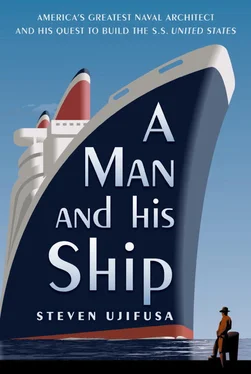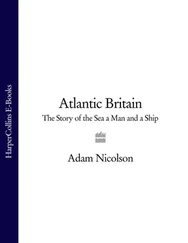Vinson, Carl, 182–89
“Vinson Acts,” 182
Vinson Naval Plan, 182
Virginian, 42
Virginia Pilot-Ledger Star, 357
Volstead Act, 115
wages, 208, 212, 216, 217, 301, 347, 354
Wagner Hochdruck turbine company, 125
waiters, 265, 275, 330
Waldorf-Astoria hotel, 38, 41, 102, 278, 315, 339
Wales, Prince of, 114
Walker, Jimmy, 114
Wall Street, 21–22, 33, 100, 156
Walter Kidde & Company, 348
Ward Line, 106, 119, 131, 132–33
Warms, William F., 130–33
War Production Board, 179–80
war profiteering, 181–89, 211, 227, 229, 236, 313
Warren, Lindsay, 183, 217, 224, 227, 228, 280–84, 319
Washington, 128, 166–69, 198, 212, 294
Washington, D.C., 143, 179–89, 269
“Washington Merry-Go-Round” column, 155
Washington Naval Conference (1921), 107
Washington Navy Yard, 57–59, 62, 182
Watt, Richard M., 43
Weather, 340
welding, 230–31, 237, 238
Wendell, Raymond, 251
Westinghouse, 142, 231, 266, 356
Westminster College, 217–18
West Point, USS, 180
whistles, 120, 204, 240, 245, 274, 300, 306, 309, 311, 370
Gibbs’s death and, 350–51
White House, 179, 236
White Star Line, 9, 16, 24, 37–44, 67, 75, 92, 97, 106, 116
Cunard’s merger with, see Cunard White Star Line Limited
Majestic and, 81–82
rate war and, 39
ships retired by, 154
see also Titanic
Whitworth fluid-pressed steel, 30
Wich, Kurt, 330
Widener, George, 45
Widener, Harry, 45
Widener, Peter, 10, 14, 23, 45
Wilhelm II, Kaiser of Germany, 24, 39, 51, 64, 69
William Cramp & Sons, 4–5, 105, 108, 110, 111
William Cramp & Sons Ship and Engine Building Company, 11
Williams, J. Scott, 256
Wilmott, Roger, 130–31
Wilson, Woodrow, 53, 55, 63, 64, 75, 76, 104
winds, 7, 8, 26, 88, 131, 136
United States and, 264, 265–69, 271, 294, 306, 307, 311, 314, 349, 360
Windsor, Duchess of, 323, 326–27, 349
Windsor, Duke of, 323, 326–27, 349
“Winged Victory of Samothrace, The,” 290
wireless sets, 45
Wister, Owen, 60
Wolf, Otto, 63–64
women:
at Gibbs & Cox, 231–33, 321–22, 366
superstition and, 269–70, 279
United States maiden voyage and, 296, 302
wood, 132, 158, 201, 340
in Mauretania, 27
United States and, 246, 248–49, 253, 260, 317
Woodward, J. B., Jr., 222, 263, 266
World Trade Center, 368
World War I, 50–54, 60, 62–70, 79, 94, 96, 112, 223
Emergency Shipbuilding Program in, 118
troop transports in, 50, 52, 64–68, 89, 117, 197
Truman in, 198
veterans of, 89
World War II, 7 n, 163–89, 193–95, 197–99, 213, 223, 273, 342, 368
aircraft design and, 214
blackout in, 177
bombing in, 165, 167, 198, 204, 213, 225
end of, 195, 198, 204
fate of great liners in, 164–66
Gibbs’s awareness of threat of, 147
Marshall in, 236
refugees in, 166, 167, 169
start of, 161
technological advances and, 207, 249, 261
troop transports in, see troop transports, in World War II
U.S. entry into, 169, 171, 173–74, 183
war profiteering and, 181–89, 211, 227, 229, 236, 313
wrench “accident,” 73
Wyman, Jane, 323
yachts, 125, 155, 247, 340, 366, 368
Yonan, David, 249
York, Lewis E., 257
Yourkevitch, Vladimir, 122, 175, 176, 336–37
Ziegenbein, Leopold, 120
Zippler, Norman, 80, 124, 138, 245, 260
“A Man and His Ship, a hugely entertaining re-creation of the age of the ocean liner, will leave older readers nostalgic, younger readers envious, and all of them engrossed in the drama of William Francis Gibbs as he fights to build the greatest ship of them all, the S.S. United States. The Cunard Line once boasted that ‘getting there is half the fun.’ Now Steven Ujifusa has given us the other half.”
—A. J. LANGGUTH, author of
Driven West
“A marvelous narrative of America’s premier naval architect.”
—BARRETT TILLMAN, author of
Enterprise

SHIRA YUDKOFF
STEVEN UJIFUSAis a historian living in Philadelphia and he serves on the Advisory Council of the SS United States Conservancy. He received his master’s degree in historic preservation and real estate from the University of Pennsylvania and his B.A. in history from Harvard University.
MEET THE AUTHORS, WATCH VIDEOS AND MORE AT
SimonandSchuster.com
• THE SOURCE FOR READING GROUPS •
JACKET DESIGN BY LAURIE CARKEET
JACKET ILLUSTRATION BY JOHN MATTOS
PORTHOLE: DORLING KINDERSLEY/GETTY
COPYRIGHT © 2012 SIMON & SCHUSTER
Simon & Schuster Newsletter
Thank you for purchasing this Simon & Schuster eBook. We hope you enjoyed reading it.
Sign up for our newsletter and receive special offers, access to bonus content, and info on the latest new releases and other great eBooks from Simon & Schuster.

or visit us online to sign up at
eBookNews.SimonandSchuster.com

Simon & Schuster
1230 Avenue of the Americas
New York, NY 10020
www.SimonandSchuster.com
Copyright © 2012 by Steven Ujifusa
All rights reserved, including the right to reproduce this book or portions thereof in any form whatsoever. For information address Simon & Schuster Subsidiary Rights Department, 1230 Avenue of the Americas, New York, NY 10020.
First Simon & Schuster hardcover edition July 2012
SIMON & SCHUSTER and colophon are registered trademarks of Simon & Schuster, Inc.
The Simon & Schuster Speakers Bureau can bring authors to your live event.
For more information or to book an event contact the Simon & Schuster Speakers Bureau at 1-866-248-3049 or visit our website at www.simonspeakers.com.
Designed by Akasha Archer
Library of Congress Cataloging-in-Publication Data
Ujifusa, Steven.
A man and his ship : America’s greatest naval architect and his quest to build the S.S. United States / Steven Ujifusa.
p. cm.
Includes bibliographical references and index.
(ebook : alk. paper)
1. Gibbs, William F. (William Francis), 1886–1967. 2. Naval architects—United States—Biography. 3. Gibbs & Cox—History—20th century. 4. United States (Steamship) 5. Ocean liners—United States—History—20th century. I. Title.
VM140.G52U55 2012
623.8092—dc23
[B]
2011049883
ISBN 978-1-4516-4507-1
ISBN 978-1-4516-4508-8 (ebook)
St. Louis was almost two modern football fields long, and at 11,500 gross tons, the third-largest ship in the world, after Cunard’s 12,000-gross-ton Campania and Lucania of 1893.
One knot is the equivalent of 1.15 land miles per hour. Thirty-three knots, or 33 nautical miles per hour, translates to about 37 miles per hour. But land measures don’t give a full picture of the speed involved when moving through water. The fastest nineteenth-century sail-powered clipper ships could average 16 knots; the great aircraft carriers of World War II averaged about 32 knots. The Cunard liner Queen Mary held the Blue Riband for the fastest Atlantic crossing from 1938 to 1952, averaging just over 30 knots.
Читать дальше















